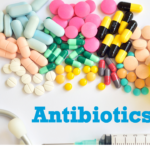Antibiotics: 10 Types, Classification, List, Examples

Antibiotics are a class of medications used to treat bacterial infections. They work by killing or inhibiting the growth of bacteria, thereby helping the body’s immune system to fight off the infection. Antibiotics are not effective against viral infections, such as the common cold or flu, as viruses are structurally different from bacteria.
There are many different types of antibiotics, each with its own spectrum of activity against different types of bacteria. Some antibiotics are broad-spectrum, meaning they can target a wide range of bacteria, while others are narrow-spectrum, targeting specific types of bacteria.
The first modern-day antibiotic was used in 1936. Before antibiotics, 30 percent of all deaths were caused by bacterial infections. Thanks to antibiotics, previously fatal infections are curable. Today, antibiotics are still powerful, life-saving medications for people with certain serious infections. They can also prevent less-serious infections from becoming serious. Most antibiotics are only available with a prescription from your doctor. Some antibiotic creams and ointments are available over the counter.
How Antibiotics Works
Antibiotics work in different ways to combat bacterial infections. The specific mechanism of action can vary depending on the type of antibiotic, but here are some common ways in which antibiotics work:
1. Inhibition of bacterial cell wall synthesis: Many bacteria have a cell wall that provides structural support and protection. These antibiotics interfere with the synthesis of bacterial cell walls, weakening them and causing the bacteria to burst due to osmotic pressure.
2. Inhibition of protein synthesis: Bacteria rely on the production of proteins to carry out essential functions. They interfere with bacterial protein synthesis by targeting specific components of the bacterial ribosomes, which are responsible for protein production. By disrupting this process, these antibiotics prevent bacteria from producing vital proteins, leading to their inhibition or death.
3. Inhibition of nucleic acid synthesis: Bacteria need to replicate their DNA and RNA to grow and reproduce. These antibiotics inhibit the enzymes involved in DNA replication and transcription, preventing bacteria from replicating their genetic material properly.
4. Disruption of bacterial metabolic pathways: Some antibiotics interfere with specific metabolic pathways that are essential for bacterial survival. They inhibit enzymes involved in the synthesis of folic acid, which is crucial for bacterial DNA and protein production. By disrupting these pathways, antibiotics impede bacterial growth and replication.
5. Damage to bacterial cell membranes: Certain antibiotics disrupt the integrity of bacterial cell membranes. They interact with the lipids in the cell membrane, causing leakage of cellular contents and eventual cell death.
It’s important to note that antibiotics are designed to target bacteria and do not have an effect on viruses. This is why antibiotics are ineffective in treating viral infections like the common cold or flu.
The choice of antibiotic depends on various factors, including the type of bacteria causing the infection, its susceptibility to different antibiotics, the site of infection, and the overall health of the patient. Healthcare professionals consider these factors when prescribing antibiotics to ensure the most effective treatment.
What are the 10 types of antibiotics?
Here is a list of the 10 commonly used classes or types of antibiotics:
1. Penicillins: This class includes antibiotics such as penicillin, amoxicillin, and ampicillin. They inhibit bacterial cell wall synthesis and are effective against a wide range of bacteria.
2. Tetracyclines: Tetracycline, doxycycline, and minocycline are examples of tetracycline antibiotics. They interfere with bacterial protein synthesis and are commonly used to treat acne, respiratory tract infections, and sexually transmitted infections.
3. Cephalosporins: Cephalosporin antibiotics, including cephalexin and ceftriaxone, also disrupt bacterial cell wall synthesis. They are often used to treat various infections, such as urinary tract infections, pneumonia, and skin infections.
4. Quinolones: Quinolones, such as ciprofloxacin and levofloxacin, work by inhibiting bacterial DNA replication and synthesis. They are frequently used to treat respiratory and urinary tract infections, as well as certain types of gastrointestinal infections.
5. Lincomycins: Lincomycin and clindamycin are examples of lincomycin antibiotics. They inhibit bacterial protein synthesis and are commonly used to treat serious infections caused by anaerobic bacteria and some gram-positive bacteria.
6. Macrolides: Macrolide antibiotics, including erythromycin, azithromycin, and clarithromycin, also interfere with bacterial protein synthesis. They are often used to treat respiratory tract infections, skin infections, and sexually transmitted infections.
7. Sulfonamides: Sulfonamide antibiotics, such as sulfamethoxazole-trimethoprim (co-trimoxazole), inhibit bacterial folic acid synthesis. They are used to treat urinary tract infections, respiratory tract infections, and certain types of gastrointestinal infections.
8. Glycopeptides: Vancomycin is a well-known glycopeptide antibiotic that disrupts bacterial cell wall synthesis. It is primarily used to treat serious infections caused by gram-positive bacteria, including methicillin-resistant Staphylococcus aureus (MRSA) infections.
9. Aminoglycosides: Aminoglycoside antibiotics, such as gentamicin and amikacin, interfere with bacterial protein synthesis. They are commonly used in the treatment of severe bacterial infections, including those caused by gram-negative bacteria.
10. Carbapenems: Carbapenems, such as imipenem and meropenem, are broad-spectrum antibiotics that inhibit bacterial cell wall synthesis. They are often reserved for treating serious infections caused by multidrug-resistant bacteria.
It’s important to note that this is not an exhaustive list, and there are other classes and types of antibiotics available. Additionally, within each class, there may be several different specific antibiotics with varying properties and uses. The choice of antibiotic depends on the specific infection, the susceptibility of the bacteria, and other individual patient factors, and should be determined by a healthcare professional.
When To Use Antibiotics
Antibiotics are specific for the type of bacteria being treated and, in general, cannot be interchanged from one infection to another. When antibiotics are used correctly, they are usually safe with few side effects.
However, as with most drugs, antibiotics can lead to side effects that may range from being a nuisance to serious or life-threatening. In infants and the elderly, in patients with kidney or liver disease, in pregnant or breastfeeding women, and in many other patient groups antibiotic doses may need to be adjusted based on the specific characteristics of the patient, like kidney or liver function, weight or age. Drug interactions can also be common with antibiotics. Healthcare providers are able to assess each patient individually to determine the correct antibiotic and dose.
When NOT To Use Antibiotics
Antibiotics are not the correct choice for all infections. For example, most sore throats, coughs, and colds, flu, or acute sinusitis are viral in origin (not bacterial) and do not need an antibiotic. These viral infections are “self-limiting”, meaning that your own immune system will usually kick in and fight the virus off. In fact, using antibiotics for viral infections can increase the risk of antibiotic resistance, lower the options for future treatments if an antibiotic is needed, and put a patient at risk for side effects and extra costs due to unnecessary drug treatment.
What do antibiotics do to your body?
Antibiotics help stop infections caused by bacteria. They do this by killing the bacteria or by keeping them from copying themselves or reproducing. The word antibiotic means “against life.” Any drug that kills germs in your body is technically an antibiotic.
What are the most common side effects of antibiotics?
All medications have side effects, including antibiotics. Antibiotics are medications that treat infections by killing bacteria or other organisms or slowing their growth. An antibiotic side effect occurs as an unwanted reaction that occurs in addition to the desirable therapeutic action of the antibiotic you are taking. Side effects of antibiotics can range from mild allergic reactions to severe and debilitating adverse events. When used appropriately, most antibiotics are relatively safe with few side effects. However, some side effects may interfere with your ability to finish the medication. In these cases, you should contact your doctor.
Common side effects of antibiotics include:
- Mild skin rash or other allergic reactions
- Soft stools, short-term diarrhea
- Upset stomach, nausea
- Loss of appetite
- Fungal (yeast) vaginal infections or oral thrush
More severe antibiotic side effects include:
- Severe allergic reaction that results in difficulty breathing, facial swelling (lips, tongue, throat, face)
- Severe watery or bloody diarrhea; Clostridium difficile infection
- Stomach cramps
- Yeast infections in the mouth or vagina (white discharge and severe itching in the vagina or mouth sores or white patches in your mouth or on your tongue)
These side effects are extremely variable; however, there are some common side effects that may occur within larger antibiotic drug classes. Long term side effects of antibiotics can occur, but are infrequent.
Antibiotic Safety
When prescribed appropriately and taken correctly, antibiotics can be very effective. They can shorten the time you are sick and keep the disease from spreading to others. Perhaps because they seem so effective, doctors may have a tendency to prescribe them too often, even when there is not anything for them to treat and you would have gotten better just as quickly without them. Sometimes this is done in the hopes of preventing bacterial infection. However, over time, many bacteria adapt to resist antibiotics, making these medications less effective or unable to work at all. This occurs even in bacteria not responsible for the illness that just live in your body.
Antibiotic resistance is harmful. As more antibiotics are introduced into our environment, by either over-prescribing or entering our food chain through their use in the dairy, poultry, and livestock industries, more strains of bacteria have the potential to become resistant. Examples of bacterial strains that are already resistant to antibiotics include:
Methicillin-resistant Staphylococcus aureus (MRSA)—These dangerous bacteria can cause infections in areas such as the lungs, skin, blood, and bones.
Multi-drug resistant Klebsiella—These bacteria can cause pneumonia, bloodstream infections, and urinary tract infections (UTIs).
Multi-drug resistant Escherichia coli—These bacteria can cause digestive system infections, bloodstream infections, and UTIs.
Some bacteria may be resistant to only one antibiotic, while others are resistant to a range of antibiotics. Bacteria can pass this ability to resist multiple antibiotics onto other bacteria, even without the presence of antibiotics.
These multidrug-resistant bacteria create a challenge for doctors. Patients with conditions caused by these types of bacteria not only endure long hospital stays, but they may also have to take many drugs in hopes that one of the medications or the combination of medications will work. Often these drugs can be toxic and ineffective. Patients infected with antibiotic-resistant bacteria are more likely to die from their illnesses.
The most important cause of antibiotic resistance is the inappropriate use or overuse of antibiotics. As much as 30 percent of antibiotic use is thought to be unnecessary. This is because antibiotics are often prescribed when they aren’t needed.
Several important steps can be taken to decrease inappropriate antibiotic use:
- Take antibiotics only for bacterial infections. Don’t use antibiotics for conditions caused by viruses such as the common cold, flu, cough, or sore throat.
- Take antibiotics as directed by your healthcare provider. Using the wrong dose, skipping doses, or taking it longer or shorter than directed might contribute to bacterial resistance. Even if you feel better after a few days, talk with your healthcare provider before discontinuing an antibiotic.
- Take the right antibiotic. Using the wrong antibiotic for an infection might lead to resistance. Don’t take antibiotics prescribed for someone else. Also, don’t take antibiotics left over from a previous treatment. Your healthcare provider will be able to select the most appropriate antibiotic for your specific type of infection.




